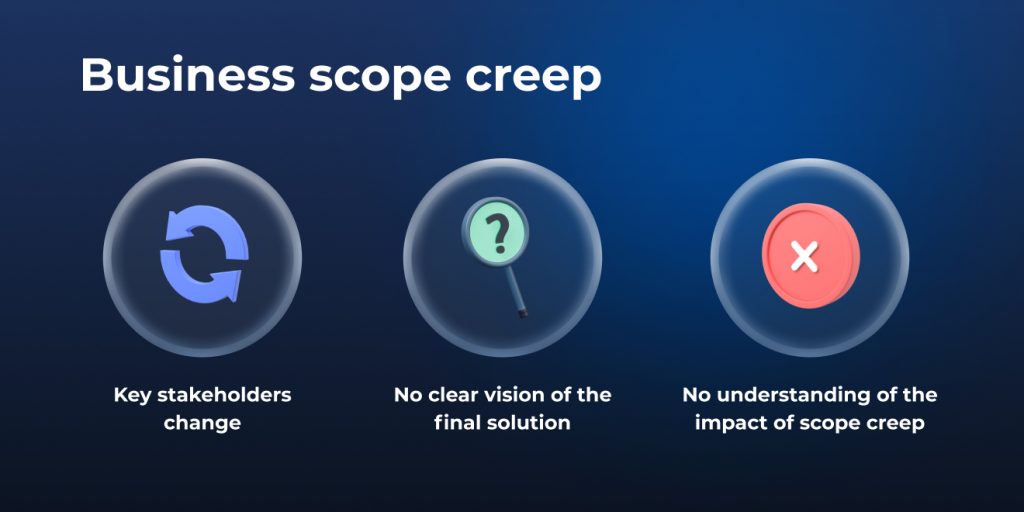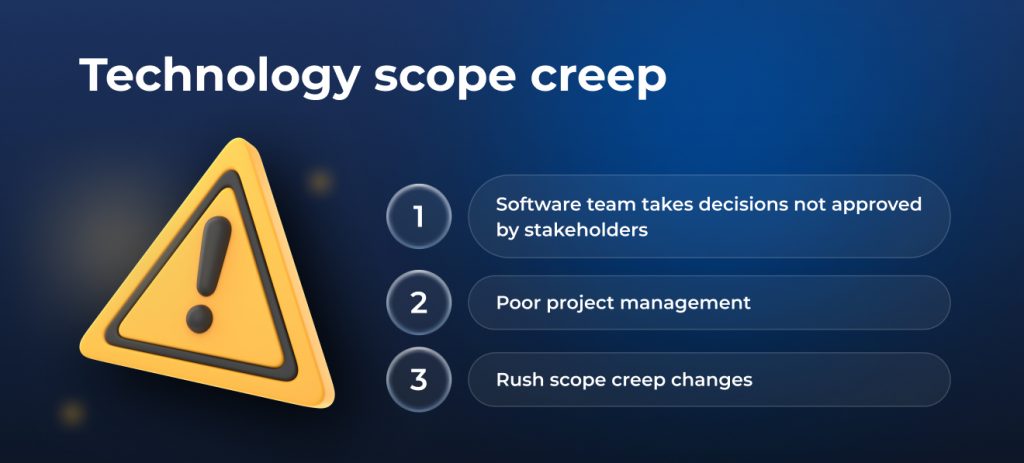Table of Contents
Today, we would like to explore one of the common risks that appear on various software projects, which is called scope creep. This occurrence happens due to tons of change requests to some parts within the software project after the project roadmap was approved, and the development process started.
This risk is rather predictable and can be easily addressed with the application of scope creep management practices that we will discuss further in this article.
What is scope creep?
Scope creep is a common issue to happen on software projects, where the scope of work needs to be clearly defined from the very beginning. So this is a deviation from the initially outlined project scope which entails adding more features and requirements to the project which leads to higher costs and delayed delivery.
Scope creep is very insidious as commonly everything starts from a request for a small change or additional features and can grow into complete changes in project scope. All these requests aim at the project manager, who needs to take responsibility and agree or decline the requested changes from the client.
However, it is pivotal to understand that some changes are acceptable but if the number of changes becomes huge, it may take time to complete the deadlines. It can lead to a completed project failure as the project scope is expanded, but the project budget remains the same. Hence, the business analyst and project manager are tasked with discussing the clients` requests and explaining the consequences under the condition of frequency of project scope changes.
Types of scope creep
Generally, there are two types of scope creep depending on the newly appeared customer requirements—business scope creep and technology scope creep. Both of them appeared due to various reasons, but accepting the asked changes in both cases has the same results—more tasks on projects that required more time and budget. Here is how they actually differentiate.
Business scope creep
The golden rule of successful software development is being aware of the business goals of this solution for key stakeholders and for the development, having a clear vision of the final software, and moving in the same direction.

When the software project objectives are not precisely specified before the start of the development, there is a risk of business scope creep when key stakeholders don’t clearly explain what they want, therefore the project manager leads the team in the wrong direction.
Business scope creep occurs when there are changes in the client’s business, for instance, new investors and company stakeholders came and their requirements and product vision are completely different from the initial documents in the project vision. It is greatly risky to change the entire software goal in the middle of the development process, but the team needs to be always ready for changes that don’t depend on them.
To prevent serious issues on the project later, a good project manager needs to outline the ins and outs of the project scope and prepare the approximate scope creep process that is allowed on the project. Stakeholders have to understand the correlation of expanding scope with time and project budget, so communication and proper project documentation is a key to ensuring that the requested changes are actually essential.
Technology scope creep
The main reason why this type of scope creep appears is caused by the self-sufficient decisions of the team during the development process. For example, an engineering team tries to deliver the software in shorter terms than were agreed in the beginning or add features that weren’t approved by stakeholders but seem to be necessary by engineers.

Usually, such decisions are made in a rush to cover the newly appeared project issues or due to now knowing all project requirements properly. Surely, it happens with no approval even from the project manager. So, as we mentioned before, it is recommended to consider scope creep risks and create a change control process to deal with it with no harm to the project budget and deadlines.
Top reasons why scope creep arises in the software project
If project scope creep is considered in advance in most software projects, what are the reasons it still may occur? Further, we will look into the matter.
Long-term projects are at higher risk
Large-scale software projects commonly last 12+ months. And it is a common case when client business and needs and project requirements change, but the probability of these changes is typically discussed and documented in the very beginning.
It happens in cases when the entire project scope is not divided into consistent milestones, with regular check-ups and reviews of the completed part of the software. The development team gets lost in what is done, what needs to be done next, and what still requires improvement. The team and stakeholders lose the final goal and product vision, focusing on small achievements.
Variable project requirements
Unclearly defined project requirements during the discovery stage can cause lots of issues and failures in the software project, one of which is scope creep. This is a primary task for a business analyst to outline all business requirements toward a software solution, document them, and ensure the project team and stakeholders are on the same page and comprehend the final goals and product vision via creating the project roadmap with clear deadlines for each iteration.
Gaps in project management
Poor project scope leadership for the project manager is another reason for project scope creep. Surely, project managers cannot apply micromanagement and follow each engineer and the task to be done. But the main task is to explain to the project team the project scope and divide the project into milestones with precise deadlines and scope of tasks for each part of the project.
Each milestone that lasts 2 weeks needs to be discussed and reviewed to move forward in the right direction. Some scope changes are acceptable, but they need to be discussed with the project team and stakeholders to ensure their necessity and possibility to apply.
Unrealistic objectives from the stakeholder side
Some clients, especially those who have no experience working with software providers, may set unrealistic goals, estimations, and deadlines. For example, a client may request to add certain features in the middle of the development process, as it seems like a tiny change for this client.
However, adding a new feature requires more working hours, maybe more engineers, and therefore more time and budget. The probability of scope change is possible only for time & material or a dedicated team contract, as a fixed price literally entails no more resources than were discussed and approved in the beginning.
Communication gaps
Communication between stakeholders, project managers, and the team defines the success of the development process and software delivery, especially if we view cooperation with outsourced development teams. The frequency of meetings depends on the initially set communication flow and software development approach that the software house uses.
For example, in Altamira, we follow the Scrum methodology that divides the entire software project into sprints, each of which lasts for 2 weeks and then discussed with the team and stakeholders to review and make improvements if needed. Exactly communication helps preventing scope creep on the project as the client needs to be explained what consequences it has and what resources it requires.
Testing may involve scope changes
If the testing stage of the software development life cycle entails collecting user feedback from the completed software solution, it may influence the project scope, nevertheless, it is supposed to be done already. However, in this case, the scope changes need to be deeply analyzed as not all of them have to be rejected in order to improve user experience after launch.
Some requested features or adjustments may have a positive impact on the developed software, and the team needs to create a plan for turning these changes not life, but it requires additional budget and resources.
7 ways to avoid scope creep on software projects
#1 Reach negotiation between the team and stakeholders
To ensure smooth cooperation with the development team, it is pivotal for the two sides to be on the same page and set the project priorities. Everyone engaged in a project has to completely comprehend what issues the client came with, how the future software will resolve, outline its goals, and what methodology will be applied.
Moreover, all these discussions should be left unseen, every detail related to the project has to be recorded providing the possibility to revise the project goals one more time. This helps the team and stakeholders bear in mind the expected final results and move in the right direction.
#2 Project vision
Every software project includes a certain list of documents, starting from the contract between the stakeholder and the software house to every tiny detail related to software functionality. Proper project documentation is crucial to keep in mind the initial project scope during the development process and be aware of what resources are required, how they will be diluted, and if scope creep is possible due to available resources.
At Altamira, we create a Project Vision for each new client we have. It is detailed project documentation that commonly includes the overall description of the client company, and future solution, client business needs, and pains, the team members, the technologies, and so on. Also, project documents contain project roadmap, milestones, deadlines, tasks with tracked hours, etc.
#3 Scope changes are under control
Every experienced software provider knows of lots of possible risks that may arise during the software development process. Hence, they apply risk management practices that aim to predict as many potential risks as possible to prevent or know the quick solution to them.
Therefore, scope creep is not something rare or not existing, and the team news to be prepared. So, it is crucial to discuss the flow and cases under which the scope changes are acceptable and not acceptable. For instance, here is how it can work—the request for change appears, then it goes through analysis and discussion to decide whether it can be included in the project resources and is worth them at all.
#4 Cases when to say “no”
Commonly, software teams try their best to provide their clients with the high-quality services that they expect, just like we do in Altamira. But sometimes clients may feel cloudy about the functions of the future solution and ask for some changes or additional work.
If these changes are sincerely excessive and will negatively impact the whole better, business analysts and project managers have to learn to say “no”, and it is totally okay. After the solution is completed successfully, the client will be only thankful for your wise decisions in critical moments.
#5 Communication is pivotal
Qualitative communication between the team and stakeholders is one of the most effective solutions for preventing scope creep and resolving it if needed.
Frequent meetings before the start of the development process help understand what is important for clients, what requirements are priorities and what is not, discuss what the team needs to provide high-quality code, and so on. Through many years of experience in the market, the Altamira team learned to find an approach for each client individually.
Surely, Scrum entails constant chatting and online meetings like retrospective calls to discuss the completed tasks with the team, demo calls to show what features have been done and how they work, calls to outline the further steps, and planning the next iteration of the project. But some clients may require more involvement in the process, and it is still essential to prevent micromanagement.
#6 Schedule each sprint on the project
Schedule means everything for the smooth software development process, and it is important to keep the client involved in the project schedule. It commonly includes the deadlines for each iteration, the applied resources like engineers, the number of hours, used technologies, and completed pieces of functionality available for testing.
This shows that the process follows the original scope plan in the budget and timeline, making it impossible to include any changes. So, if the request for scope change arises, the client is aware of what it means for the project and what consequences it will have for the entire project management and schedule, and they take the responsibility for that. Due to the change in control flow, each request will surely be discussed and determined as a priority or non-priority.
#7 Take benefit from project management software tools
No software project can go without project management tools that simplify lots of processes like assigning tasks to the right executors, checking the progress of each task as well as the project overall, keeping the client up-to-date on what is going on in the project, etc. It is also pivotal not to overdo a number of tasks and collect the bigger small jobs in one instead of separately tiny jobs into different tasks.
Summary
All in all, we see that scope creep is neither a good nor a bad occurrence during the development process. The further steps and overlay project success completely depend on whether the requests for scope changes are worthy and will have a positive impact on software functionality or will just spend the client’s time, money, and team’s effort.
In the next article dedicated to scope creep that is coming to our blog next week, we will share the most effective practices we apply in Altamira to predict and quickly resolve scope creep consequences on various software projects.




